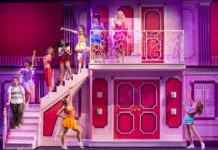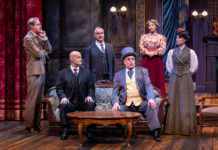This post contains affiliate links and our team will be compensated if you make a purchase after clicking on the links.
Born out of hundreds of hours interviewing real Broadway dancers, known as “gypsies,” A CHORUS LINE is a collection of these real stories told through words, song and of course dance during an audition process for an upcoming musical. The show kicks it off with a seven-minute opener and the familiar request “Let’s do the whole combination from the top, away from the mirror, a five, six, seven eight!”
After passing the initial cut, these performers are told by the director that “I think it would be better if I knew something about you – about your personalities” in order to aid his selection. In this powerful setting – a bare black Broadway stage with nothing but some iconic upstage mirrors, it is here that each of the 17 performers, some reluctantly, open up about their past.
One candidate named Mike talks about being the youngest of twelve and attending his sister’s dance class. Sheila speaks of dance as an escape from her disappointing family life. Bebe admits she doesn’t see herself as beautiful, but dancing allows her to feel beautiful. Paul’s monologue about performing as a drag queen remains the show’s high point, despite his admission having less cultural impact today than when this play premiered to audiences in 1975. It is clear that unlike Americans today who audition for shows like American Idol for the sole purpose of stardom, these performers aren’t looking for instant fame – they are simply looking for a job. Nowhere is this clearer than the story of Cassie, a former star who the director feels is “dancing down” by appearing in the chorus line.
For someone who grew up watching pseudo-operas like Phantom, self-referential shows like The Producers, and special effect shows like Wicked, the utter simplicity and sincerity of A CHORUS LINE is shocking. Robin Wagner’s set design is clever in it’s plainness and packs a punch when the mirrors are put to work. The updated lighting design by Natasha Katz has a fun use of colored gels to transport us into the character’s flashback sequences. Despite a few staging adjustments, director Bob Avian didn’t set out to radically remake this show and it’s clear that audiences approve. This current production recouped its investment of $8 million in just 19 weeks after opening.
The highlight of the show is the finale “One,” which is often referenced as one of the greatest moments in Broadway musical history. These high-kicking performers earned a spontaneous standing ovation from our sold-out performance the old fashioned way: they showcased their dancing skills with energetic professionalism.
Tickets are on sale at the OCPAC Box Office or by clicking here www.ocpac.org .
Discover more from Socalthrills.com
Subscribe to get the latest posts sent to your email.











